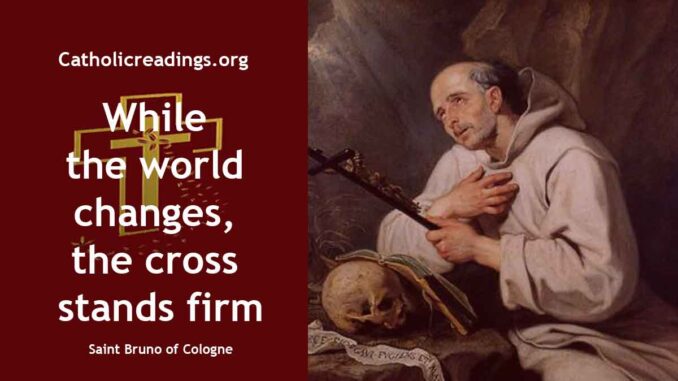St Bruno was born in Cologne Germany around the year 1030 AD.
He was the founder of the Carthusian Order.
He died on October 6 1101 in Serra San Bruno, Vibo Valentia, Italy.
His feast day is celebrated on October 6 every year in the Catholic Church.
| Saint Bruno, Priest Biography | |
|---|---|
 |
|
| Date of Birth | 1030 AD |
| Place of Birth | Cologne Germany |
| Profession | Confessor, Hermit, Monk |
| Place of Work | Germany and Italy |
| Date of Death | October 6 1101 |
| Place of Death | Serra San Bruno, Italy |
| Feast Day | October 6 |
| Canonization | By Pope Gregory XV on February 17 1623 |
| Patron Saint of | 1. Germany, 2. Calabria, 4. Carthusians, |
Saint Bruno Life History
St Bruno studied theology in Reims, France, and was ordained as a priest around 1055 AD. Gervais, the Archbishop of Reims made Bruno the head of the Episcopal school which included directing schools and overseeing all the educational establishments of the Archdiocese of Reims.
St Bruno took charge of the Episcopal school for nearly 20 years and maintained its prestige. He acquired an excellent reputation as a theologian and a philosopher who taught the likes of Pope Urban II, Bishop Rangier of Reggio and Bishop Robert of Langres.
Archbishop Manasses de Gournai replaced Archbishop Gervais as the Archbishop of Reims and in 1075, Manasses appointed Bruno as the chancellor of the Roman Catholic Archdiocese of Reims. This job entailed the daily administration of the archdiocese.
Archbishop Manasses was violent and did not seem to care much about the smooth running of the Archdiocese. In 1076, St Bruno and other clergy denounced Archbishop Manasses as unfit to manage the Archdiocese of Reims.
Manasses Gournai was suspended, and out of anger and retaliation, he confiscated and destroyed the houses and properties of the clergy who plotted against him. St Bruno went into hiding until 1080 when Manasses went to take refuge with Roman Emperor Henry IV.
When St Bruno resurfaced again, the faithful wanted to make him the Archbishop but he refused saying that he had made a vow to give up secular concerns and become a hermit. He was joined in that course by his friends Raoul and Fulcius.
At first, St Bruno became a hermit under Abbot St Robert of Molesmes, who together with others founded the Cistercians.
Bruno later realized that his vocation lied elsewhere and in 1084, together with six other companions, he went to Bishop Hugh of Grenoble who gave them a mountainous and uninhabited spot in the lower Alps of the Dauphiné called La Grande Chartreuse, which became their hermitage.
These seven hermits built an oratory and individual cells, followed the rule of St Benedict, studied a lot, and lived a very austere and prayerful life thus began the Carthusian Order.
When Eudes of Châtillon, one of Bruno’s earlier students, became Pope Urban II, he wished to continue reforming the Church against the influence from Antipope Clement III and Roman Emperor Henry IV. The best person to help him do this work was St Bruno. He called Bruno to Rome in 1090.
St Bruno became an adviser to the Pope although he did this reluctantly. He wished so much to return to his hermitage.
Pope Urban II even offered to make him the Archbishop of Reggio Calabria but Bruno begged to return to his austere, solitary, and prayerful life.
Urban II wished to keep Bruno in Italy so that he could be called when needed. Bruno therefore, in 1091 was given by Roger I, Count of Sicily and Calabria, a small forested high valley, where he and a few other followers constructed a wooden chapel and cabins to stay. Later on, the monastery of St Stephen was built in 1095 at La Torre in Calabria.
St Bruno’s Death
St Bruno died on October 6 1101 in Serra San Bruno located in the Province of Vibo Valentia in the Italian region of Calabria.
Legacy
After his death, the Carthusians of Calabria and his disciples too, praised St Bruno’s three chief virtues of extreme mortification, his great spirit of prayer, and devotion to the Blessed Virgin.
The Carthusians proclaim The Blessed Virgin Mary, Mother of God as the chief patron of all the houses of the order.
Canonization and Feast Day
St Bruno was never formally canonized because the Carthusian Order maintains a strict observance of humility. In 1514, Pope Leo X granted the Carthusians permission to celebrate his feast but did not include the feast in the Tridentine Calendar.
However, in 1623, Pope Gregory XV included his feast on October 6 in the General Roman Calendar for celebration.
St Bruno is the Patron Saint of
- Calabria
- Germany
Other Catholic Saints whose Feast Days are in October
Related Links
Powered By SEO Experts
Follow @ReadingCatholic
